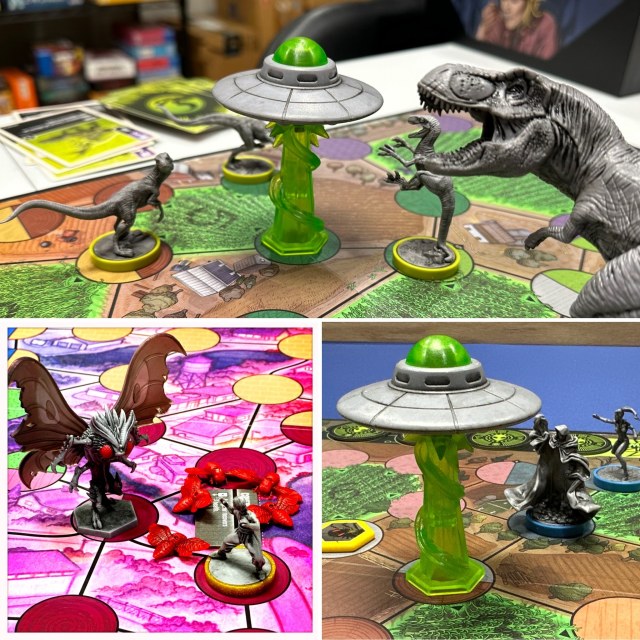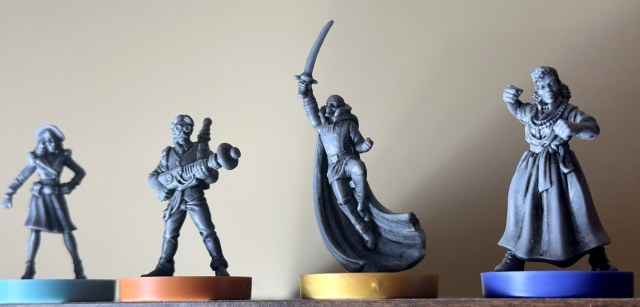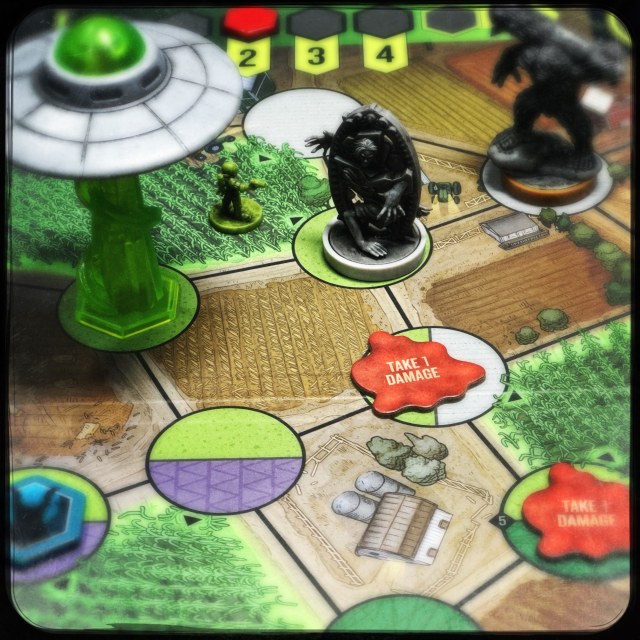
Since 2019, I’ve been a devoted fan (and playtester) for the Unmatched: Battle of Legends game system – and been part of epic face-offs between so many different heroes in so many diverse locations. (There are – if you’ve acquired every bit of the Unmatched output from Restoration Games – currently 20 different locations and 47 different heroes that can be set against each other.)*
Now, for the first time, those heroes gather together not to fight each other but battle shoulder to shoulder against monsters of legend, bent on destruction and/or world domination. Or, since this is Unmatched, you can use any of the four included heroes to battle each other and/or any other hero in the series.
Unmatched for the Uninitiated
I’m well aware that some of you have not had the opportunity to play the wonderful goodness that is Unmatched – so, a short primer on how the game works is in order. (Yes, I know, some of you have played before. A lot. You can skip to the next heading.)
Unmatched is a skirmish battle game, driven by card play and fought on a variety of boards. On your turn, you get two actions:
- Maneuver – draw a card from your personal deck & optionally move your fighter(s)
- Attack – play a card face-down to initiate a melee or ranged attack
- Scheme – play a Scheme card from your hand for its effect
You win by reducing your opponent’s hero to zero hit points.
If this sounds a lot like Star Wars: Epic Duels, you’re not wrong. That 2002 mass-market game is the forefather of this amazing combat system. (If you want more detail, I did a deep-dive into the differences in my original Unmatched review.)
What’s In the Box?
The first thing you’ll notice when opening the box for Tales to Amaze! is that there’s a lot of stuff packed into it: multiple card decks, miniatures, plastic counters, and a number of punchboards in order to create hit trackers and various other bits for the game. There are also three rulebooks: the Core Rules (which teach the basics of playing Unmatched), the Set Rules (which go over the special rules related to the four new heroes), and the Tales to Amaze! Instructions (which teach how to play the cooperative adventure game).
Once you’ve gone through the assembly process, you’ll have 4 playable characters (2 with sidekicks), 2 boss monsters, 6 minion monsters… and the card decks for each of those. In addition, you will have a deck of initiative cards and a deck of Amazing Event cards. Finally, there’s a good bit of other tokens/bits – bridges, webs, acid blobs, invasion markers, and the like.
Come meet the crew!

The Heroes
- Nikolai Tesla – armed with a ranged weapon that uses his Tesla coils to charge up and trigger various effects
- Dr. Jill Trent – she has two potential gadgets (she can only use one per turns) and a trusty sidekick to help her figure out the smartest way to eliminate the threats
- Annie Christmas – the riverboat captain and her gambler husband (sidekick) have lots of tricks up their respective sleeves: she’s more dangerous when she’s the underdog in a fight and he’s a gambler with some very slick moves
- The Golden Bat – a Japanese pulp hero… with a skull for a head and a rapier to do serious damage with.
The Boss Monsters
- Mothman – he fights to cut off his territory from the human world, destroying bridges and generally beating our heroes to a pulp
- The Martian Invader – busily beaming up cows and sending his little green men (no, not the cute kind from Toy Story but more like the ones from Mars Attacks!) to establish a permanent foothold on our planet
The Minions
- Ant Queen – who is a boss in her own right… she not only moves the threat marker, but she also adds cards to the Initiative deck, making her stronger & faster.
- Blob – this monstrosity spits acid and is just generally difficult to kill
- Jersey Devil – he scares cards out of players hands (and occasionally cancels player cards when they are played)
- Skunk Ape – He’s basically a brute with an anger problem
- Tarantula – her webs slow down heroes & sidekicks… plus it’s easier for her to attack players caught in her silky strands
- The Loveland Frog – another minion who adds cards to the deck and thus just keeps coming like some kind of demonic Energizer Bunny (only he’s a frog)

Game Play
The starting point is that pretty much everything from the hero (player) side works just like normal Unmatched. There are specific exceptions (dealt with in the rulebook) but it’s an easy variant to jump into if you’ve played Unmatched before.
The player(s) have an overriding objective: get the villain (boss) to zero health before they accomplish their nefarious scheme. Alternately, loss comes if the boss finishes their four-step plan (destroy the bridges or complete the invasion) OR if all player fighters are defeated (both heroes and sidekicks).
Each player is assigned a player number (1 through 4) and an initiative card of that number is included in the initiative deck. In addition, each boss and minion starts with a card in the initiative deck… which is thoroughly shuffled and dealt out one at a time to trigger player and bad guy turns.
Note: the boss & minion initiative cards may have immediate effects (activating the bad guy) as well as end of round effects (that are triggered in the order the cards were revealed.) Some of the bad guys also have multiple cards that are added to the deck as play proceeds, making them more and more difficult to deal with. (Dadgum Loveland Frog…)

In general, bosses and minions will attempt to close with the nearest hero or sidekick and attack. Just like the original Unmatched design, the player will choose a card to play (or choose not to play a card) and then flip over the top card of the bad guys deck. Damage ensues as well as particular effects – all of those are resolved just like basic Unmatched.
Your objective is to defeat (kill, eliminate, send back to Mars, etc.) the Boss. If you manage to do the same to some or all of the minions, great – but it’s not necessary. (I did not say it was a bad idea – leave them alone and they will hound you to death.)
Variety Is the Spice of Life
Just in case you don’t think the game is difficult enough, there are Amazing Event cards that ramp up the difficulty. In general, we’ve found the game easiest as a solo game – particularly with a character with big attack values. On the other hand, the game becomes trickier with more players and more minions.

After 11 plays, we’re 6-5… with two of those losses using an Amazing Event card.
We’ve also played with heroes not found in the Tales to Amaze! Box: while Bruce Lee easily defeated the Martian Invader (is that even a surprise?) and the T-Rex/Raptors team sent them back to the stone age, the team of Beowulf, Little Red, and Sindbad were not as successful. (And after finishing writing this, I played a quick two player game against the invaders with Bigfoot & Bloody Mary… and hurt them pretty bad before getting stomped.)
Final Thoughts
I have to admit – my younger son & I were early version playtesters of this box for Restoration Games. We were not impressed and found the prototype at that point to be a bit clunky and not particularly fun.
And this is why development/playtesting is so important… because the final product is incredibly enjoyable to play and a worthy addition to a line of games I love. (I haven’t played with new heroes in a 1v1 or 2v2 game, but both my sons assure me that they’re great medium difficulty heroes and lots of fun to play in that setting as well.)
If you enjoy Unmatched, don’t let the “cooperative” nature of Tales to Amaze! put you off. If you’re a cooperative fan, give this a try – even if you’re skeptical of its origins in a fighting game. The quality of the production and the smoothness of gameplay is really something special.
Math Nerdery
* I had some of the more math-inclined writers on the OG staff figure out just how many possible combinations you can currently come up with to play Unmatched: Here’s what they (well, Dan) came up with:
Assuming that:
- 1. Any hero can be played on any map.
- 2. Any two heroes can oppose each other.
- 3. Any two heroes can pair up for a 2v2.
- 4. You can’t buy multiple copies of a set and play the same hero against themselves.
- 5. We can ignore details such as which side of a map each team sets up on.
Then there are 21,620 1v1 scenarios and 10,701,900 2v2 scenarios.
That’s a lot of scenarios, folks.
My copy of Tales to Amaze! was purchased through the Kickstarter for the game. I have received review copies of Unmatched: Buffy, For King & Country, and Teen Spirit… the rest of my Unmatched collection was purchased with my hard-earned cash. Which reminds me – anyone want to buy my copy of Epic Duels?
Thoughts from the Opinionated Gamers
Erik Arneson (4 plays) – Mark sums up my thoughts very well. I’m a huge fan of Unmatched, but I was very skeptical that a cooperative Unmatched game would work. Thankfully, my confidence in the team at Restoration Games was enough to make me a Kickstarter backer, because Unmatched: Tales to Amaze is absolutely fantastic. I haven’t played with heroes from the other sets yet, but I’m eager to give that a try.
Ratings from the Opinionated Gamers
I love it – Mark Jackson, Erik Arneson
I like it –
Neutral –
Not for Me –
